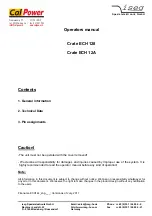
Safety
4
than the plug when disconnecting
from receptacle. Damage to the cord
or charger could occur and create
an electric shock hazard. Replace
damaged cords immediately.
Ŷ
Make sure cord is located so that it
will not be stepped on, tripped over,
come in contact with sharp edges or
moving parts or otherwise subjected
to damage or stress. This will reduce
the risk of accidental falls, which could
cause injury, and damage to the cord,
which could result in electric shock.
Ŷ
Keep cord and charger from heat to
prevent damage to housing or internal
parts.
Ŷ
Do not operate charger with a
damaged cord or plug, which could
cause shorting and electric shock. If
damaged, have the charger replaced
by an authorised service centre.
Ŷ
Do not operate charger if it has
received a sharp blow, been dropped,
or otherwise damaged in any way.
Take it to an authorised serviceman
for electrical check to determine if the
charger is in good working order.
Ŷ
Do not disassemble charger. Take it
to an authorised serviceman when
service or repair is required. Incorrect
reassembly may result in a risk of
electric shock or fire.
Ŷ
Unplug charger from outlet before
attempting any maintenance or
cleaning to reduce the risk of electric
shock.
Ŷ
Disconnect charger from the power
supply when not in use. This will
reduce the risk of electric shock or
damage to the charger if metal items
should fall into the opening. It also will
help prevent damage to the charger
during a power surge.
Ŷ
Risk of electric shock. Do not touch
uninsulated portion of output connector
or uninsulated battery terminal.
BATTERY SAFETY WARNINGS
Li-ion
Ŷ
Do not dispose of used battery packs
in the household refuse or by burning
them. To ensure proper disposal of
waste battery packs and protect the
environment, hand over old battery
packs to your RYOBI distributor.
Ŷ
Segregate electronic waste properly
by removing integrated battery packs
from the main unit before disposal.
Hand them over to applicable collection
points.
Ŷ
To remove the integrated battery pack:
Separate the housing shells from
one another by removing the screws.
Disconnect the battery pack from the
circuit and remove.
NOTE:
When opened, the product is
no longer reusable or serviceable and
should be disposed of properly.
Ŷ
Before removing the battery pack
from the power tool, switch on the
product until the battery pack is fully
discharged.
Ŷ
Ensure that the battery pack to be
disposed of cannot come in contact


































